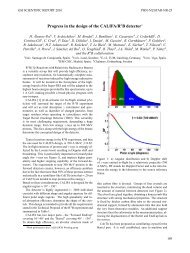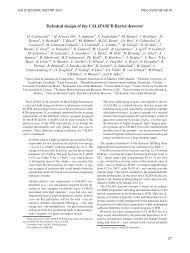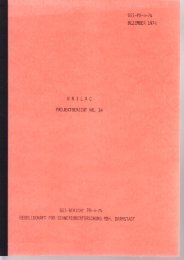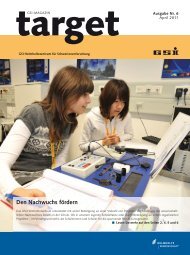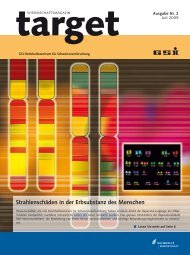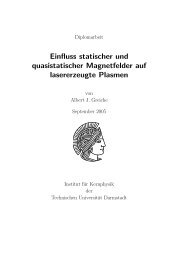download block - GSI Helmholtzzentrum für Schwerionenforschung
download block - GSI Helmholtzzentrum für Schwerionenforschung
download block - GSI Helmholtzzentrum für Schwerionenforschung
Create successful ePaper yourself
Turn your PDF publications into a flip-book with our unique Google optimized e-Paper software.
<strong>GSI</strong>-ACCELERATORS-01 <strong>GSI</strong> SCIENTIFIC REPORT 2009<br />
128<br />
SIS Experiments<br />
The heavy ion synchrotron delivered beams to 26 fixed<br />
target experiments and to 7 experiments at the ESR. In<br />
total 4321 hours of target time have been achieved. The<br />
summary is given in Table 3.<br />
In 2009 the main SIS user was FOPI. About 1250 hours<br />
of beam time were delivered to this experiment. The target<br />
time for ESR (direct beam and beam via FRS) increased<br />
to 1097 hours. For about 482 hours beam was<br />
delivered to the FRS.<br />
Table 3: Beam delivered to SIS/ESR experiments<br />
Time Ratio<br />
Target time for experiments 4321 h 73,5%<br />
Time for retuning 39 h 0,7%<br />
Accelerator setup 650 h 11,1%<br />
Ion source service 100 h 1,7%<br />
Unscheduled down time 769 h 13,1%<br />
Total beam time 5879 h 100%<br />
Accelerator operation<br />
Figure 2 shows the total beam time for all accelerated<br />
isotopes during 2009. Over the year 18 different isotopes<br />
have been accelerated. The rare isotopes ( 6 Li, 7 Li, 34 S,<br />
48 Ca, 54 Cr) were produced by the ECR ion source, which<br />
has been operated for 4757 h. Besides Li these beams<br />
were mainly provided to UNILAC experiments. The Penning<br />
ion source was mainly used for 96 Ru, 58 Ni and 197 Au<br />
(in total 2632 hours of operation). The high-current ion<br />
source operation lasted for 2725 hours. Especially 40 Ar<br />
and proton beams were delivered from the MUCIS ion<br />
source. 238 U was accelerated from the MEVVA ion source<br />
for 533 hours.<br />
Table 4: Statistics of all unscheduled down time events<br />
Down<br />
time<br />
No. of<br />
events<br />
Power supplies 339 h 303<br />
Vacuum and structures 159 h 111<br />
Beam diagnostics 34 h 31<br />
Operation 37 h 37<br />
Safety-/ Interlock system 177 h 59<br />
Ion Sources 103 h 71<br />
RF system 287 h 465<br />
Controls 94 h 58<br />
Infrastructure 69 h 27<br />
Others / 55 h 51<br />
Total of unscheduled<br />
down time<br />
1354 h 1189<br />
In Table 4 all unscheduled down time events are shown<br />
in more detail. Compared to 2008 about 200 hours less of<br />
down time events were recorded due to a decrease of<br />
breakdowns of power supplies and ion sources.<br />
An earth leak of the main feed-in of the SIS power supplies<br />
caused a break of two days for SIS operation. The<br />
renewed control of the radiation safety system of<br />
SIS/ESR caused a lot of interruption in the first <strong>block</strong>.<br />
This system was upgraded and runs very reliably meanwhile.<br />
During commissioning for the forth <strong>block</strong> the<br />
breakdown of one drift tube cooling threatened a stop of<br />
the operation. However, a special mode of low duty cycle<br />
operation was tested successfully. This mode allowed<br />
standard beam conditions for SIS injection and the operation<br />
could be continued. For the UNILAC experiments<br />
with energies above 5.9MeV/u the duty cycle needed to<br />
be restricted. The drift tube was replaced during the subsequent<br />
shutdown.<br />
isotopes<br />
1H<br />
6Li<br />
7Li<br />
12C<br />
34S<br />
40Ar<br />
48Ca<br />
54Cr<br />
56Fe<br />
58Ni<br />
96Ru<br />
122Sn<br />
124Sn<br />
129Xe<br />
136XE<br />
181Ta<br />
197Au<br />
238U<br />
0 500 1000 1500 2000 2500<br />
operation (h)<br />
Figure 2: Total beam time for the different ion species<br />
For accelerator experiments at the UNILAC 144 hours,<br />
at SIS 301 hours, and at ESR 95 hours beam were delivered,<br />
which is for SIS an increase by a factor of three<br />
compared to last year.<br />
References<br />
[1] OLOG <strong>GSI</strong> operation logbook<br />
[2] Report of beam time coordinator, this report





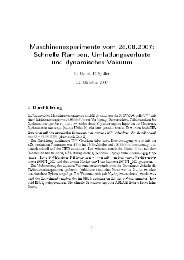
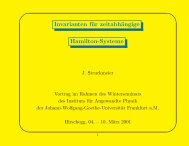
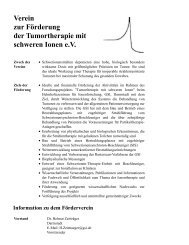
![GS I -P-]-17 - GSI Helmholtzzentrum für Schwerionenforschung](https://img.yumpu.com/20698964/1/184x260/gs-i-p-17-gsi-helmholtzzentrum-fur-schwerionenforschung.jpg?quality=85)

